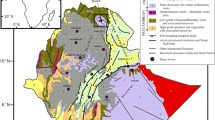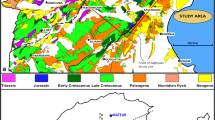Abstract
The structure of a ~250-m-long asymmetrical pull-apart basin developed in carbonate rocks at the Galilee heights, Israel, is herein analyzed. The reconstruction of the basin geometry is based on detailed mapping and LiDAR measurements of fault scarps. The architecture of faults is then used as a boundary condition for calculating the stress pattern in the vicinity of the basin, using a dislocation model. The basin is found to be an asymmetrical V-shaped structure bordered by two longitudinal oblique right-lateral strike–slip faults. The strike of one of the faults is bent at the eastern edge of the basin, generating a transverse boundary fault which joins the second boundary fault orthogonally. The overall lateral displacement is smaller than the basin length, and no transverse or diagonal fault is observed in the western end of the basin. The deformation around the basin is mostly displayed by fractures. Yet, folds and fault branches are observed near the tips of the boundary faults and near kink points of fault segments. Stress analysis obtained by the three-dimensional model is in general agreement with the orientation of fractures and location of high deformation regions in and around the basin. Based on our observations, we present a conceptual model which demonstrates the development of asymmetric basins in releasing bends and sheds light on the structures of similar large pull-apart basins.










Similar content being viewed by others
References
Armijo R, Meyer B, Navarro S, King G, Barka A (2002) Asymmetric slip partitioning in the Sea of Marmara pull-apart: a clue to propagation processes of the North Anatolian Fault? Terra Nova 14:80–86
Aydin A, Nur A (1985) The types and roles of stepovers in strike slip tectonics. In: Biddle KT, Christie-Blick N (eds) Strike-slip deformation, basin formation, and sedimentation. Society of economic paleontologists and mineralogists, special publication, vol 37, pp 35–45
Bartov Y, Sagy A (2004) Late Pleistocene extension and strike-slip in the Dead Sea basin. Geol Mag 141:565–572
Bartov Y, Steinitz G, Eyal M, Eyal Y (1980) Sinistral movement along the Gulf of Aqaba—its age and relation to the opening of the Red Sea. Nature 285:220–221
Basile C, Brun JP (1999) Transtensional faulting patterns ranging from pull-apart basins to transform continental margins: an experimental investigation. J Struct Geol 21:23–37
Ben-Avraham Z (1992) Development of asymmetric basins along continental transform faults. Tectonophysics 215(1):209–220
Ben-Avraham Z, Lyakhovsky V, Schubert G (2010) Drop-down formation of deep basins along the Dead Sea and other strike-slip fault systems. Geophys J Int 181:185–197
Brace WFD, Bombolakis EG (1963) A note on brittle crack growth in compression. J Geophys Res 68:3709–3713
Brew G, Lupa J, Barazangi M, Sawaf T, Al-Iman A, Zaza T (2001) Structure and tectonic development of the Ghab basin and the Dead Sea fault system, Syria. J Geol Soc 158(4):665–674
Burchfield BC, Stewart JH (1966) “Pull-apart” origin of the central segment of Death Valley, California. Geol Soc Am Bull 77:439–442
Cunningham WD, Mann P (2007) Tectonics of strike-slip restraining and releasing bends. Geol Soc Lond Spec Publ 290:1–12
Dooley T, McClay K (1997) Analog modeling of pull-apart basins. AAPG Bull 81:1804–1826
Eyal Y, Reches Z (1983) Tectonic analysis of the Dead Sea Rift Region since the Late-Cretaceous based on mesostructures. Tectonics 2:167–185
Eyal Y, Eyal M, Bartov Y, Steinitz G, Folkman Y (1986) The origin of the Bir Zreir rhomb-shaped graben, eastern Sinai. Tectonics 5:267–277
Flexer A (1964) On the paleogeography of the Senonian and the Maastrichtian in northern Israel. PhD thesis, Hebrew University of Jerusalem (in Hebrew)
Flexer A, Freund R, Reiss Z, Buchbinder B (1970) Santonian paleostructure of the Galilee. Isr J Earth Sci 19:141–146
Freund R (1970) The geometry of faulting in Galilee. Isr J Earth Sci 19:117–140
Freund R, Tarling DH (1979) Preliminary Mesozoic palaeomagnetic results from Israel and inferences for a microplate structure in the Lebanon. Tectonophysics 60:189–205
Garfunkel Z (1997) The history and formation of the Dead Sea basin. In: Niemi T, BenAvraham Z, Gat J (eds) The Dead Sea: the lake and its setting. Oxford University Press, New York, pp 36–56
Garfunkel Z (1998) Constraints on the origin and history of the Eastern Mediterranean basin. Tectonophysics 298:5–35
Gölke M, Cloetingh S, Fuchs K (1994) Finite-element modelling of pull-apart basin formation. Tectonophysics 240:45–57
Hamiel Y, Lyakhovsky V, Agnon A (2004) Coupled evolution of damage and porosity in poroelastic media: theory and applications to deformation of porous rocks. Geophys J Int 156:701–713
Heimann A, Ron H (1993) Geometric changes of plate boundaries along part of the northern Dead Sea transform: geochronologic and paleomagnetic evidence. Tectonics 12:477–491
Hinsch R, Decker K, Wagreich M (2005) 3-D mapping of segmented active faults in the southern Vienna Basin. Quat Sci Rev 24:321–336
Jaeger JC, Cook NG, Zimmerman R (2009) Fundamentals of rock mechanics, 4th edn. Wiley, New York
Joshi GR, Hayashi D (2010) Finite element modelling of the pull-apart formation: implication for tectonics of Bengo Co pull-apart basin, southern Tibet. Nat Sci 2:654
Katzman R, ten Brink US, Lin J (1995) Three-dimensional modeling of pull-apart basins: implications for the tectonics of the Dead Sea basin. J Geophys Res Solid Earth 100:6295–6312
Mann P (2007) Global catalogue, classification and tectonic origins of restraining-and releasing bends on active and ancient strike-slip fault systems. Geol Soc Lond Spec Publ 290(1):13–142
Massonnet D, Rossi M, Carmona CS, Adragna FDR, Peltzer G, Feigl K, Rabaute T (1993) The displacement field of the Landers earthquake mapped by radar interferometry. Nature 364:138–142
Matmon A, Enzel Y, Zilberman E, Heimann A (1999) Late Pliocene and Pleistocene reversal of drainage systems in northern Israel: tectonic implications. Geomorphology 28:43–59
Matmon A, Wdowinski S, Hall JK (2003) Morphological and structural relations in the Galilee extensional domain, northern Israel. Tectonophysics 371:223–241
McClay K, Dooley T (1995) Analogue models of pull-apart basins. Geology 23:711–714
Naylor MA, Mandl GT, Supesteijn CHK (1986) Fault geometries in basement-induced wrench faulting under different initial stress states. J Struct Geol 8:737–752
Okada Y (1985) Surface deformation due to shear and tensile faults in a half-space. Bull Seismol Soc Am 75:1135–1154
Okada Y (1992) Internal deformation due to shear and tensile faults in a half-space. Bull Seismol Soc Am 82:1018–1040
Petrunin AG, Sobolev SV (2008) Three-dimensional numerical models of the evolution of pull-apart basins. Phys Earth Planet Inter 171:387–399
Picard L (1965) The geological evolution of the quaternary in the central-northern Jordan graben, Israel. Geol Soc Am 84:337–366
Quennell A (1959) Tectonics of the Dead Sea rift. In: Proceedings of the 20th international geological congress, Mexico, pp 385–403
Reches Z (1987) Mechanical aspects of pull-apart basins and push-up swells with applications to the Dead Sea transform. Tectonophysics 141:75–88
Rodgers DA (1980) Analysis of pull-apart basin development produced by en echelon strike-slip faults. In: Balance PF, Reading HG (eds) Sedimentation in oblique-slip mobile zones. International Association of Sedimentologists Special Publication vol 4, pp 27–41
Ron H (1984) Paleomagnetic investigation of the fault structure of Galilee-northern Israel. PhD thesis, Hebrew University of Jerusalem
Ron H, Eyal Y (1985) Intraplate deformation by block rotation and mesostructures along the Dead Sea transform, northern Israel. Tectonics 4:85–105
Ron H, Freund R, Garfunkel Z, Nur A (1984) Block rotation by strike-slip faulting: structural and paleomagnetic evidence. J Geophys Res 89:6256–6270
Savage JC, Lisowski M (1995) Strain accumulation in Owens Valley, California, 1974 to 1988. Bull Seismol Soc Am 85:151–158
Schattner U, Weinberger R (2008) A mid-Pleistocene deformation transition in the Hula basin, northern Israel: Implications for the tectonic evolution of the Dead Sea Fault. Geochem Geophys Geosyst 9(7). doi:10.1029/2007GC001937
Segall P, Pollard DD (1980) Mechanics of discontinuous faults. J Geophys Res 85:4337–4350
Segall P, Pollard DD (1983) Nucleation and growth of strike-slip faults in granite. J Geophys Res Solid Earth 88:555–568
Serpa L, De Voogd B, Wright L, Willemin J, Oliver J, Hauser E, Troxel B (1988) Structure of the central Death Valley pull-apart basin and vicinity from COCORP profiles in the southern Great Basin. Geol Soc Am Bull 100:1437–1450
Sims D, Ferrill DA, Stamatakos JA (1999) Role of a ductile decollement in the development of pull-apart basins: experimental results and natural examples. J Struct Geol 21(5):533–554
Sneh A, Bartov Y, Weissbrod T, Rosensaft M (1998) Geological map of Israel, 1:200,000. Israel Geological Survey (4 sheets)
Sylvester AG, Smith RR (1976) Tectonic transpression and basement-controlled deformation in San Andreas fault zone, Salton Trough, California. AAPG Bull 57:74–96
Tchalenko JS (1970) Similarities between shear zones of different magnitudes. Geol Soc Am Bull 81:1625–1640
ten Brink US, Ben-Avraham Z, Bell RE, Hassouneh M Coleman, Andreasen DG, Tibor G, Coakley B (1993) Structure of the Dead Sea pull-apart basin from gravity analyses. J Geophys Res Solid Earth 98:21877–21894
Wetzler N, Sagy A, Sagy Y, Nahmias Y, Lyakhovsky V (2015) Active transform fault zone at the fringe of the Dead Sea basin. Tectonics 34(7):1475–1493
Woodcock NH, Fischer M (1986) Strike-slip duplexes. J Struct Geol 8(7):725–735
Ye J, Liu M, Wang H (2015) A numerical study of strike-slip bend formation with application to the Salton Sea pull-apart basin. Geophys Res Lett 42:1368–1374
Acknowledgments
This work is dedicated to the memory of Prof. Hagai Ron who first showed us the Dalton basin during a field trip. We thank Yaakov Mizrachi for his help in the fieldwork and Michele Cooke for helpful discussion. We thank the editor Wolf-Christian Dullo and the reviewers Dickson Cunningham and Ariel Heimann for their insightful comments and constructive review which helped improve this manuscript.
Author information
Authors and Affiliations
Corresponding author
Rights and permissions
About this article
Cite this article
Sagy, A., Hamiel, Y. Three-dimensional structure and evolution of an asymmetric pull-apart basin. Int J Earth Sci (Geol Rundsch) 106, 1619–1630 (2017). https://doi.org/10.1007/s00531-016-1374-4
Received:
Accepted:
Published:
Issue Date:
DOI: https://doi.org/10.1007/s00531-016-1374-4




